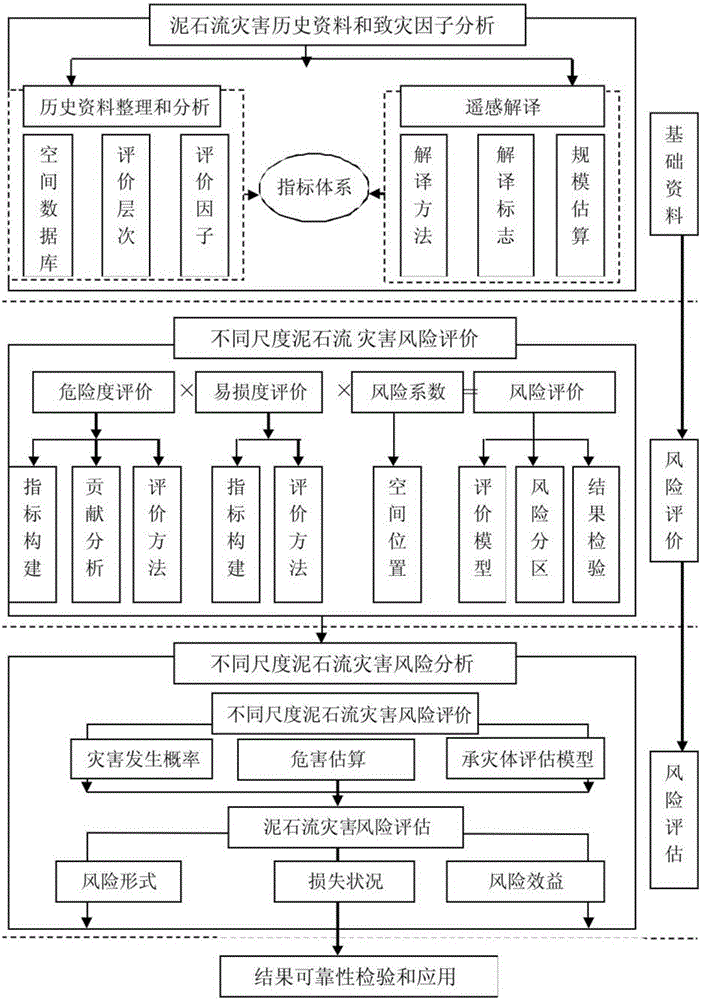Multi-scale debris flow risk assessment method for earthquake disturbance area
A risk assessment and debris flow technology, applied in special data processing applications, instruments, electrical digital data processing, etc., can solve problems such as weakness, worsening people's lives in disaster areas, and non-standard evaluation accuracy
- Summary
- Abstract
- Description
- Claims
- Application Information
AI Technical Summary
Problems solved by technology
Method used
Image
Examples
Embodiment 1
[0026] A multi-scale debris flow risk assessment method in an earthquake disturbance area, comprising the following steps:
[0027] (1) Establish a spatial database: collect recent earthquakes, historical earthquakes, and earthquake-induced debris flow data in the seismically disturbed area, and combine remote sensing image interpretation to investigate the current situation of debris flow geological disasters and their background, and clarify the main controlling factors and causes of regional debris flows. Its contribution rate, establishing a spatial database of historical earthquakes and their induced debris flows;
[0028] (2) Establish risk assessment level and scale requirements: According to the principles of assessment scale, assessment level, assessment data, assessment methods and results release, carry out risk assessment at different spatial scales from region→small watershed→small gully→secondary gully→small gully Debris flow hazard or risk assessment;
[0029] ...
Embodiment 2
[0042] Example 2: Risk assessment of debris flow at different scales
[0043] 1. Construction of evaluation index system
[0044] (1) Regional debris flow assessment index system
[0045] The regional debris flow risk assessment index system generally includes five categories: topography, hydrology and meteorology, geological conditions, and human engineering activities. Specifically, it can be divided into nine index parameters: elevation, slope, landslide point density, comprehensive precipitation index, stratum lithology, structural buffer zone, earthquake, land use, and vegetation index. Using the method of information volume, AHP and GIS technology to obtain the index weight.
[0046] (2) Evaluation index system for different scales of debris flow in small watersheds
[0047] Small watersheds can be divided into three scales of debris flow gullies: small ditch, secondary ditch, and young ditch, and different evaluation index systems have been established for the risk a...
Embodiment 3
[0055] Example 3: Vulnerability Evaluation
[0056] 1. Evaluation index system
[0057] For small- and medium-scale vulnerability assessment, from the perspective of life and property, the vulnerability assessment of small and medium-scale hazard-bearing bodies can be divided into population vulnerability, economic and ecological environment vulnerability, among which population vulnerability represents the vulnerability of life. The degree of potential loss, economic and ecological vulnerability characterizes the loss of property classes. Economic and ecological vulnerability includes two aspects: economic vulnerability and ecological vulnerability. Economic vulnerability mainly refers to the situation of fixed assets and social production in the evaluation area, specifically: building density, agricultural output value density, forestry output value density , output value density of agriculture, forestry and animal husbandry supporting services, road network density, and pu...
PUM
 Login to View More
Login to View More Abstract
Description
Claims
Application Information
 Login to View More
Login to View More - R&D
- Intellectual Property
- Life Sciences
- Materials
- Tech Scout
- Unparalleled Data Quality
- Higher Quality Content
- 60% Fewer Hallucinations
Browse by: Latest US Patents, China's latest patents, Technical Efficacy Thesaurus, Application Domain, Technology Topic, Popular Technical Reports.
© 2025 PatSnap. All rights reserved.Legal|Privacy policy|Modern Slavery Act Transparency Statement|Sitemap|About US| Contact US: help@patsnap.com



